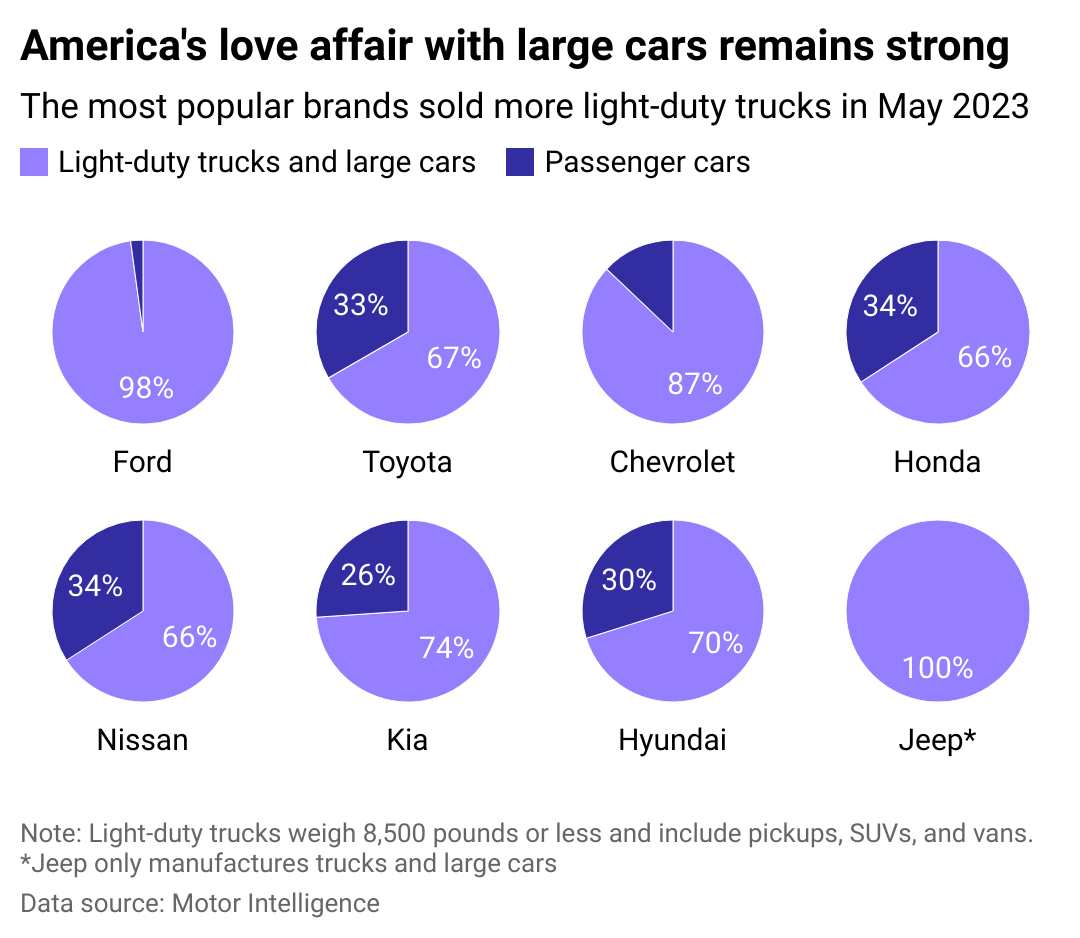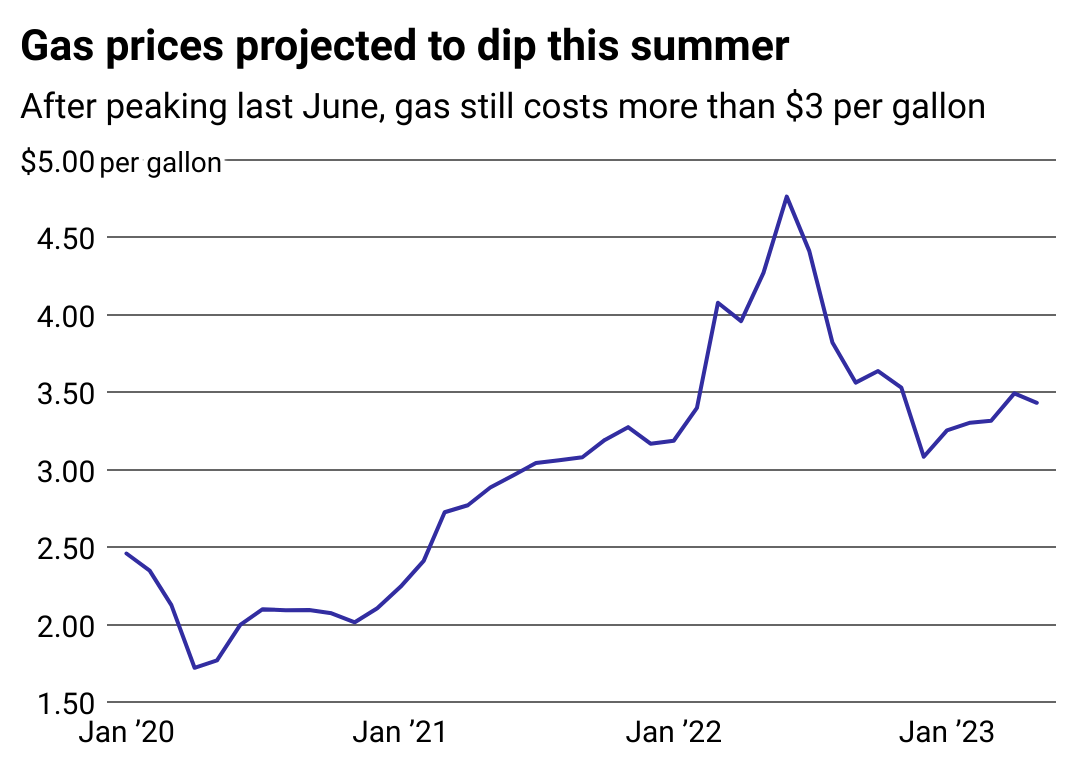Americans still love buying trucks, even as gas prices rise

VDB Photos // Shutterstock
Americans still love buying trucks, even as gas prices rise
A parking lot of F-150 pickup trucks at a Ford dealership.
Some trace the American obsession with pickup trucks back to the horse and buggy. It’s a natural evolution of our instinctual first stab at transportation. Others chalk it up to our largesse—America’s insatiable desire for bigger, shinier, newer, state-of-the-art goods.
But Americans are also known to be price-conscious—about gas prices, especially, according to Pew Research. This could be in part because our lifestyles require us to buy so much of it. In 2021, Americans bought nearly 500 gallons of gasoline for every registered vehicle in the country, according to the oil and gas trade association, the American Petroleum Institute. That puts the U.S. at the top of the list for gas consumption, with Americans using almost three times the amount of gas as China and more than 11 times the amount as Canada.
And even with gas prices sitting stubbornly at a whole dollar more on average than before the Russian invasion of Ukraine, Americans continue to buy gas-guzzling trucks and SUVs.
Americans bought more than 1 million trucks in May, accounting for more than three-quarters of all car sales, according to Motor Intelligence estimates. Of the over 40 most popular brands selling trucks, only three sold more cars in May: MINI, Dodge, and Bentley.
Insurify examined May 2023’s new car sales estimates compiled by Motor Intelligence and average gas prices from the Energy Information Administration to explore why these large vehicles have such impressive staying power in the U.S. economy today.
![]()

Insurify
Automakers sold more trucks than cars in May
Multiple pie charts showing the share of truck sales versus car sales in the 8 most popular car brands in May.
It’s a love affair in which both parties have responded to each other’s desires over recent years. The 2010s saw pickup truck and SUV sales outpace sedans as the U.S. heaved itself from the wreckage of the 2008 financial crisis. The federal government pumped lifesaving money into vehicle manufacturers like General Motors, and larger vehicles became profit leaders as sales picked up.
For fuel emission standards, Environmental Protection Agency defines a light-duty truck as a motor vehicle weighing 8,500 pounds or less primarily designed to transport property, including pickups, SUVs, and vans.
According to Federal Reserve data, overall vehicle sales hit a modern-day peak back in spring 2021 alongside the distribution of COVID-19 vaccines and the easing of restrictions on businesses.
And as Americans have bought more large vehicles, manufacturers are shifting production to match demand. In 2018, for example, Ford announced plans to end production of sedans except for its Mustang line, opting instead to double down on trucks and SUVs. GM has made similar modifications to its lineup.

Insurify
Gas prices drop but remain elevated
A line chart showing how gas prices have changed since January 2020.
Gas prices are lower than a year ago but remain well above the norms Americans may remember from before the pandemic. Drivers would be hard-pressed today to find $2 gasoline without the help of discounts.
The abnormal spike in the summer of 2022 resulted from a sudden global shift in how the world supplies oil and gas to consumers.
Russia is one of the largest suppliers of oil in the world. When it began bombing Ukrainian cities, several nations worldwide, including the U.S., scrambled to find alternative places to purchase oil. Russia’s invasion of the former satellite state kicked off an economic war as much as it fired up a proxy fight with Western democracies.
This year, the gas price has dropped to nearly $3 per gallon from a historic high of almost $5 per gallon. Oil producers in the U.S. have kicked up production in response to the turmoil, but not until after hauling in record profits thanks to high demand and low oil supply for months.
American drivers have been dealt a relative break as the summer bears down on them. But it may be unrealistic to expect a return to the sub-$3 a gallon gas from pre-pandemic times.

maxpro // Shutterstock
Why Americans are choosing trucks
Cyclists taking their bikes out of the bed of a pickup truck.
So why are Americans still leaping for the most oversized vehicles on the market, knowing they’ll be forking over even more money weekly for their gas budgets?
For one, they offer luxurious interiors and higher safety standards. The earliest SUVs were quite literally fully enclosed bodies attached to pickup truck chassis reimagined with extended cabs and seating space. Today they boast some of the roomiest and plushest interiors on the market, next to the often overlooked minivan.
And today’s pickup trucks have been updated, too. A modern Ford F-150, for example, now requires many computer chips to power its climate control, touchscreen entertainment console, automatic start and stop, and other high-tech features. The slowdown in new vehicle production coinciding with the pandemic hit truck sales as much as sedans, emphasizing today’s trucks are not the simple, gas-guzzling workhorses of the 1990s when bench seats were still standard.
The geographic differences between states where people buy the most trucks and SUVs is another factor to consider for their staying power. Along the Gulf Coast, including the states of Texas, Louisiana, and Mississippi, gasoline is relatively cheap compared with states along the West Coast and Northeastern Seaboard, where it is more expensive.
An analysis from iSeeCars, a data-driven car search and research company, looked at data from April 2022 through March 2023 and found the states with above-average truck sales also have lower-than-average gasoline prices.
It costs money to transport gas through pipelines from oil-producing regions like Texas and Pennsylvania, and consumers in more distant states pick up the tab in increased costs at the pump. In recent weeks, Southern states have enjoyed roughly 25% lower costs per gallon of gas compared with West Coast states like California, according to AAA data.
California and Washington are examples of states where new laws meant to curb emissions may put economic pressure on owners of vehicles with lower fuel efficiency, like trucks and SUVs.
And even considering variable gas costs, it’s worth considering how overall commuting behaviors have shifted in recent years as workers and employers nationwide embrace remote and hybrid work schedules, allowing some people to drive less on a daily basis.
Story editing by Jeff Inglis. Copy editing by Kristen Wegrzyn.
This story originally appeared on Insurify and was produced and
distributed in partnership with Stacker Studio.





